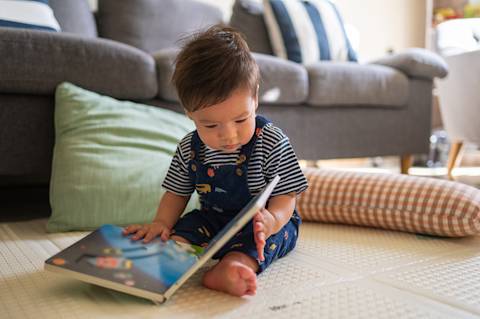After countless sleepless nights as a new caregiver, it might feel like you’ll never be able to get a full night’s sleep again. But there’s good news: With a consistent sleep training practice, you and your baby can sleep through the night.

Most babies start sleeping through the night (about 6 to 8 hours) without waking up when they’re between 3 and 4 months old, or when they weigh about 12 to 13 pounds. However, some babies may not sleep through the night until they are 6 months old or even older. It’s important to remember that all children are on their own unique timeline. Not all babies sleep through the night right away, and sleeping habits can vary widely. Most importantly, the more consistent you can be with sleep training, the more likely your child will be able to sleep through the night.
Sleep training is a process of teaching your baby how to fall asleep on their own. Generally, parents start sleep training when their baby is between 3 and 4 months old, or when their baby weighs about 12 to 13 pounds.
There are many different methods of sleep training, but all of them involve teaching your baby to self-soothe, or the ability of a baby to calm themselves and fall asleep without help from caregivers. While there are many different techniques, which we’ve listed below, the best tactic is the one that works for your family. Every family is different, so it might take a few different tries and experimenting before you find the right one for you.
Ferber, or check and console: This method involves putting your baby to bed and checking on them at intervals, gradually increasing the amount of time between checks.
Pick up, put down: This method involves putting your baby to bed and then picking them up if they cry. After a few minutes, you put them back down.
Chair method: Once you put your baby in their crib, sit in a chair next to them until they get drowsy. When they fall asleep, leave the room. If they start crying, sit in the chair nearby until they stop crying. Keep repeating this each night.
Bedtime fading: This method involves adjusting your child’s bedtime depending on how much time they typically spend crying before falling asleep. For example, if you typically put your child to bed at 7 p.m. but they cry for about a half hour, try putting them to bed at 7:30 p.m. instead. Keep adjusting by about 15 minutes until you’ve reached an ideal bedtime. This method is typically used with other sleep training tactics.
Not exactly. Night weaning is the process of making sure that your child is eating their meals during the day so they’re not waking up during the middle of the night. Talk to your pediatrician about when it’s the right time to start night weaning your baby. Sleep training is the process of teaching your baby how to fall asleep on their own.
Night weaning is not required for starting sleep training techniques or beginning to promote better sleep habits in babies. While some sleep training methods may involve reducing nighttime feedings, it ultimately depends on the specific approach chosen by you and the individual needs of your baby. It’s essential to consider your baby’s age, growth, and nutritional needs, and consult with a healthcare professional to determine the most appropriate approach for your situation.
Hunger is a common reason babies might not sleep through the night, as babies have small tummies and may need nighttime feedings. Discomfort due to a wet or soiled diaper, feeling too hot or cold, or experiencing teething pain can also disrupt their sleep. If your baby is not sleeping through the night, there are several strategies you can try to improve their sleep patterns:
Establish a consistent bedtime routine that includes calming activities like a warm bath, gentle lullabies, or an infant massage, signaling to your baby that it’s time to wind down. Ensure their sleep environment is comfortable, quiet, and helps your baby fall asleep.
Consider trying a soothing technique such as gentle rocking or gentle patting to help your baby settle.
Try out a sleep training technique listed above. Give it a fair chance for at least two to three weeks before trying a different approach. It takes time for babies to adjust to new routines and methods. Rushing to switch techniques too quickly might disrupt the progress. Each baby is unique, and finding the right sleep technique can require some trial and error to discover what works best for your little one.
If you’re concerned about your baby’s sleeping habits, talk to your healthcare provider or pediatrician to rule out any medical problems.






